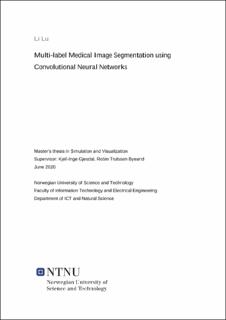| dc.description.abstract | Deep learning algorithms, in particular convolutional neural networks, are becoming a promising research tool in medical image segmentation. This thesis attempted to use annotated knee MRI images provided by Sunnmøre MR-Klinikk to study three architectures of convolutional neural networks including 3D U-net, DeepLab and a type of combined neural network and decide a system that achieves high accuracy with regard to a segmentation task which has 13 extremely imbalanced classes. For 3D U-net architecture, four advanced blocks including residual blocks, residual SE blocks, dense blocks and dense SE blocks were used to replace the standard convolution blocks in it. Because the two SE structures performed better than the other two in 3D U-net in the experiments, 3D U-net with residual SE blocks and 3D U-net with dense SE blocks were chosen as the basic networks for the other two architectures. The experiments show that DeepLab architecture is the most efficient one among the three architectures. It can achieve relatively high accuracies with both loss functions used in this thesis including dice loss and weighted dice loss. | |
